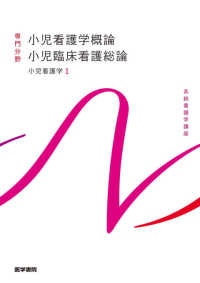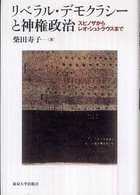- ホーム
- > 洋書
- > 英文書
- > Psychology
Full Description
The book contains contributions from Leopoldo Bleger, Catherine Desvignes, Marie-France Dispaux-Ducloux, Yvette Dorey, Cláudio Laks Eizirik, Fabienne Fillion, Serge Frisch, Lila Hoïjman, Erika Kittler, Diana Messina Pizzuti, Luc Michel, Martine Sandor-Buthaud, Andrea Scardovi, Évelyne Sechaud, and Ronnie Shaw.
Inter-analytic exchange involves associatively voicing thoughts in response to the clinical material of a patient, thus shedding light on some of the intrapsychic activity of psychoanalysts at work. Various transferential movements which may emerge must be contained and processed within this framework. For a day and a half, a group of analysts freely associates on three sessions of clinical material presented by a colleague (who remains silent during the discussion) in the presence of two moderators and a silent observer-rapporteur. This forms the core dispositif of the Specificity method.
The general framework of the method is upheld by a European research group that meets biannually. Members establish annual clinical working parties during the European Psychoanalytic Federation (EPF) Congress, where they review observer reports and work through them using, again, free association. A summary of each session is transcribed and a subgroup is dedicated to the systematic reading of the reports to produce further study. While the dispositif does not offer an absolute guarantee, over fifteen years of experience and exploration have proved its worth. It is now a recognised model within the EPF and the International Psychoanalytical Association (IPA).
This collection documents the history of the origins of the method and the discoveries made, the results of the research, and also the ongoing questioning within the EPF. It is neither exhaustive nor didactic, but instead invites you, the reader, to integrate your experiences with the ones presented herein. This is a must-read for all psychoanalysts and clinicians.
Contents
About the editors and contributors
Foreword
Cláudio Laks Eizirik
Introduction
Part I
Presentation of the "specificity" method - psychoanalysts at work
1. The working party on the "specificity of psychoanalytic treatment today"
Serge Frisch and Leopoldo Bleger
2. The method within its historical context
Leopoldo Bleger and Serge Frisch
3. Construction of the dispositif
Serge Frisch and Leopoldo Bleger
4. Presentation of a clinical group and its discussion in the Paris Group, "The Red Blanket"
Yvette Dorey
5. Gourmet psychoanalysis, or attempting to describe the work of a research group
Erika Kittler
Part II
Clinical insights - inter-analytic exchanges
6. Moderating a group of analysts listening to clinical material
Catherine Desvignes
7. Specificity of the method from the presenter's perspective
Martine Sandor-Buthaud
8. The silent support of the tripod - intersecting views: From the role of the rapporteur to the function of the observer
Marie-France Dispaux-Ducloux and Lila Hoïjman
9. The crossing: A psychoanalytic journey into the heart of a group setting
Fabienne Fillion
10. About candidate group work
Ronnie Shaw
Part III
Theoretical insights - Towards a new field of investigation
11. Free association and free discourse
Luc Michel
12. Unconscious communication in inter-analytic work
Diana Messina Pizzuti
13. What do specificity groups teach us about psychoanalytic specificity?
Andrea Scardovi
14. The clinical narrative in the working party on specificity
Leopoldo Bleger
15. The group as infant in front of the primal: Grasping, pointing, free-associating in specificity groups practice
Andrea Scardovi
16. Outcomes and results
Leopoldo Bleger and Serge Frisch
Postscript
Évelyne Sechaud
References
Index








